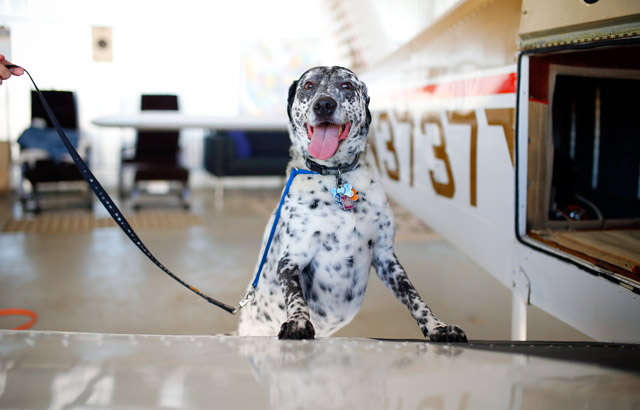
Photography by Chris Rose
Some of them stay with you. Long after they’ve joined their new families and begun new lives, you wonder how they’ve gotten on: whether they’ve made friends, and learned to relax and play, and enjoy this sudden security. Odds are they forgot their adventure in the air almost as soon as they were back on the ground. Still, you find yourself wondering—would they feel any flicker of recognition if they caught your scent again?
 Genny was one of those. She was a beautiful little thing, a brown-and-white mix about nine months old, mostly boxer or bull terrier. Wanting to make the most of every rescue flight, I had checked the bulletin board for other dogs that might be able to ride along with the two small mothers and six puppies I had offered to take from Morgantown, West Virginia, to the Queen City Airport in Allentown, Pennsylvania. Her posting stopped me cold:
Genny was one of those. She was a beautiful little thing, a brown-and-white mix about nine months old, mostly boxer or bull terrier. Wanting to make the most of every rescue flight, I had checked the bulletin board for other dogs that might be able to ride along with the two small mothers and six puppies I had offered to take from Morgantown, West Virginia, to the Queen City Airport in Allentown, Pennsylvania. Her posting stopped me cold:
Genny was left to die in a plastic bag in the parking lot across from the shelter. She needs to go from kill shelter to rescue ASAP.
She had nearly suffocated. There was no decision to make. I’d do whatever was necessary.
Clarksburg turned out to be as convenient as Morgantown for the other rescue group, so I merely had to add an extra leg of about 60 nautical miles each way—and get in and out of the Greenwood Lake Airport just south of the New York-New Jersey border. The field has trees off either end of a runway that’s on the short side for my 180-horsepower Piper Arrow; constant crosswinds; and a traffic pattern laid out in exactly the wrong place—over the hills instead of the flat spot where the town is. I suppose that’s for noise abatement. Fortunately, it was February and I took off light for the flight home. I used short-field technique and was glad I did.
Though she had recovered her health, Genny was timid on her flight out—hardly surprising. A few weeks later her foster family sent me photographs. I have two favorites. One shows her barreling down a snow-covered dirt road on the family farm in the company of five other dogs, tail high, exuberant. The other is a close-up that could be a Hollywood starlet’s head shot. Later the family reported that she’d been adopted by a family with a big yard, a swimming pool, and a 7-year-old daughter who adores her.
I received one final picture taken in their family car. Genny looks excited and happy, ears pricked, mouth relaxed. I keep her photos on my office computer, and three and a half years later I still look at them.
 Her story serves as well as any other to show why people get hooked on public-benefit flying. It’s not always fun, at least not in the laugh-a-minute sense of spontaneous sightseeing excursions. Still, for me, the pleasant hours have outnumbered the uneasy ones by at least three to one. And having a practical—and possibly urgent—reason to make a specific flight gives the entire enterprise extra weight.
Her story serves as well as any other to show why people get hooked on public-benefit flying. It’s not always fun, at least not in the laugh-a-minute sense of spontaneous sightseeing excursions. Still, for me, the pleasant hours have outnumbered the uneasy ones by at least three to one. And having a practical—and possibly urgent—reason to make a specific flight gives the entire enterprise extra weight.
Like a lot of general aviation pilots, I began learning to fly for what I thought were pragmatic reasons—in my case, enjoying long weekends at the beach without spending half that time on the highway. Once I got started, I found that I just flat-out loved it. Hacking my way through Lesson 3 of the Jeppesen Private Pilot Syllabus, I realized that I was having more fun than I’d ever legally had in public. Aviation has been my most expensive vice ever since—and it has some wicked withdrawal, a phenomenon I call “low-altitude sickness.”
Flight training was its own reward. Learning and perfecting new skills is a delight when you’re interested and motivated, and in aviation there’s always a great deal more to learn. Each time I’ve begun pursuing a new rating or certificate, I’ve found a focus for my efforts—and reason to get out to the airport at least a couple of times a week.
Passing the checkride removes that focus but only increases the desire to fly. Having gained these skills and wanting to use them more, you’re suddenly without any particular reason to go here rather than there or today instead of tomorrow. Rescue flying solves that problem and then some, bolstering the satisfaction of challenging those dearly won skills with the assurance that the exercise will do some good for someone who deserves it.
Without a doubt, it’s the most rewarding flying I’ve done. I’ve landed at airports I’d never have had any other reason to visit, weathered gusty days when I easily could have been lazy and stayed home, and put those instrument and crosswind landing skills to practical use. I have had the privilege of meeting some of the most selfless, generous, hard-working people on the planet—people who will not let themselves be discouraged by the endless stream of unwanted animals and underfunded shelters that can’t afford to help them—then enjoyed the absurdity of having them be grateful to me for doing what I wanted to do anyway.
One can build considerable pride of craftsmanship in a single flight. On the day I had arranged to take English setters from two North Carolina towns to the Ohio State University Airport in Columbus, Ohio, my briefing included notice of the closure of Runway 6/24 at Person County. That got my attention, since Person County only has one runway. After a couple of quick phone calls and a new flight plan, I picked up a few tenths of actual instrument time (but no ice) on my way to Fayetteville—where the forecast 10-knot wind turned out to be 70 degrees off the runway and gusting to 22. I bought fuel. That was a good decision; the next airport, which had
no self-service, also had nobody on hand to pump.
Bucking 40-knot headwinds and mountain waves with 45 minutes less fuel than planned, I spent our two-hour crossing of West Virginia identifying possible fuel stops and comparing the quantity remaining with the GPS-calculated time to destination. At one point, pitched up at VY near Roanoke, Virginia, our groundspeed dropped to 44 knots. But the winds eased and the mountain waves abated as we clawed our way toward Ohio. Groundspeed inched up from 85 knots to 105, and we landed with a 90-minute reserve. The flight home was graced with a 30-knot tailwind. Mist gathering in the mountain valleys looked like distant rivers reflecting the moonlight.
Squeezing those 8.5 hours into two lines of my logbook, I realized that in one day I’d encountered a pretty broad selection of the challenges we face in GA. I hadn’t had to fly an instrument approach, and thank goodness I hadn’t experienced a mechanical failure. But I had dealt with an airport closure, icing risk in instrument meteorological conditions, three tricky crosswind landings, turbulence, mountain waves, brutal headwinds, uncomfortably close contingency planning after losing an expected fuel stop, and solo single-engine flight over the mountains at night.
Not to mention live animals. It doesn’t get much better than that.
Even so, the satisfaction of a job well done may be the least significant pleasure of rescue flying. It can’t compete with the pure delight on the faces of a boy and his mother meeting their new dog on the airport ramp—or the arch of his back and lift of his tail when they hug him for the very first time. Pride of airmanship runs a distant second to the gratitude of volunteers who never stop trying to find good lives for the victims of other people’s irresponsibility. Nothing compares to having played your own small part in turning misery to joy by bringing the despised and discarded to those who will love and care for them.
Is there greater fulfillment than learning a difficult skill, and then putting it to good use? If there is, I haven’t found it.



